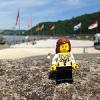Search the Community
Showing results for tags 'EBAC 2014'.
Found 6 results
-

MOC: Cologne Cathedral - Architecture for Eurobricks Event 2014
Aredhel posted a topic in Special LEGO Themes
Hi all, after some time I finally found the time to take at least some pictures of my Architecture model of Cologne cathedral. First of all: some facts about it: Cologne Cathedral (Kölner Dom) General information: The Cologne Cathedral is a Roman Catholic church in the centre of Cologne. The construction commenced in 1248. Leaving unfinished, it was halted til 1473. In the 19th century the work started again and the construction was completed, defined on the plans from 1880. Concerning to those plans the Cologne Cathedral measured a length of 144.5 meters and a width of 86.5 meters. This Gothic cathedral is the largest church in Northern Europe. The height of the two spires, which give the largest façade of any church in the world, is registered with 157 meters. It is located 250 meters beneath the River Rhine where the former Roman city boundary was located. Since 1996 the Cologne Cathedral belongs to the UNESCO-cultural heritage. Overview: The front: History: In 1164, the Archbishop of Cologne (Rainald of Dassel) acquired the relics of the Three Kings which the Holy Roman Emperor had taken from the Basilica of Sant’Eustorgio (Milan). Those relics had a great religious significance and because of this there had to be a “proper house” for them. The foundation stone was laid in 1248 by the Archbishop Konrad von Hochstaden. The eastern arm was completed in 1322 and sealed off to the rest of the construction to ensure its use. In the mid 14th century work on the west front commenced, but halted in 1473. The south tower was completed up to the belfry and for the next 400 years, the skyline of Cologne showed a crane at top of the Cathedral. During the 19th century the construction was completed. This was achieved by civic effort and, in 1842, the “Central-Dombauverein” was founded. It raised two-thirds of the costs while the Prussian state supplied the remaining third. It was finished in 1880 resuming to the medieval plans and rediscovered façade plans from 1280. The front of the west side was completed in 1911. With the 19th century romantic enthusiasm for the Middle Ages, and spurred on by the discovery of the original plan for the façade, it was decided, with the commitment of the Protestant Prussian Court, to complete the cathedral. It was achieved by civic effort; the Central-Dombauverein, founded in 1842, raised two-thirds of the enormous costs, while the Prussian state supplied the remaining third. While World War II, the cathedral suffered fourteen hits by bombs. It was not broken completely so the Cologne Cathedral stood very tall to the flattened city. The cathedral was, in later years of the war, used as navigational landmark which may be the reason that it was not destroyed completely while World War II. Repairs of the building were done around 1956. World Heritage Site In 1996, the cathedral was added to the UNESCO World Heritage List of culturally important sites. In 2004 it was placed on the "World Heritage in Danger" list, as the only Western site in danger, due to plans to construct a high-rise building nearby, which would have visually impacted the site. The cathedral was removed from the List of In Danger Sites in 2006, following the authorities' decision to limit the heights of buildings constructed near and around the cathedral. As a World Heritage Site, and with its convenient position on tourist routes, Cologne Cathedral is a major tourist attraction, the visitors including many who travel there as a Christian pilgrimage. Visitors can climb 509 stone steps of the spiral staircase to a viewing platform about 98 m (322 ft) above the ground. The platform gives a scenic view over the Rhine. Minifig in front of the Cathedral/in front of the Burj Khalifa and "the Walker": You can find more pictures here: The background information about the Cologne Cathedral was taken by wikipedia.de / wikipedia.com- 9 replies
-
- MOC
- Architecture
-
(and 2 more)
Tagged with:
-
Hi all! About 6 weeks ago the 10th Eurobricks Event took place and with it a little Architecture competition was held: One had to build and bring a sight from his home country. I chose to build the Frauenkirche in Dresden, a church that is well-known but also has some complicated features that offered a little challenge. It was destroyed during World War II and famously rebuilt after the reunification of Germany, finishing in 2005 and now probably being the most famous church in the northeast of Germany. I always loved it for its geometry and history and when I visited Dresden a couple of years ago I was quite taken by it which made the choice easy. This was the first MOC for which I used the help of virtual bricks to recreate the shape and the angles in the most exact way possible. It was quite a challenge for me as I never used anything like it before but I soon realised that for things like this it is way more effective than actually sitting in front of a pile of bricks. It was also the only option to actually get something done as I had no bricks at hand at all until I would fly home to Germany a week before the event. Therefor I spent the 4 weeks before my flight stacking bricks inside my Mac, slowly improving the MOC by using all the possible reference material I was able to require, making use of photographs, scale models, architectural drawings and even Google Earth. Once finished I suddenly realised that out of the roughly 3000 parts that I used in the model about 200 weren't in production and another 40 would cost me as much as the rest of the parts (who would have known the rarity of travis bricks in tan??) For example I had used 1x2 curved slopes as they recreated the shape of the dome perfectly and 1x3 tiles in tan as well, both parts that were never made.. In the end I was able to get around all that and ordered everything necessary, finally having time for stuff like exams or hand-ins for college In the end it took take me another week at home to eventually finish the model. Front: Back: The real thing - not my photo: This build won me a first place in the Architecture competition and a rather lovely Marina Bay Sands Many thanks to CopMike and Bonaparte for organising the event and the competition, to Whitefang for bringing the prize over, to Aredhel and Legopard for some helpful criticism and to all the eventees that made the evening such a great one and the competition so strong! I would never have thought to win this one after seeing all the other amazing entries. Please consider checking them out in this nice summary! Other entrees that were posted already: Bryggen by L@go Cologne Cathedral by Aredhel Holmenkollbakken by Cecilie Royal Albert Hall by Rufus & Pandora Water Tower by Redhead1982 I hope you like it. Comments and critique are of course appreciated. Thanks for your time!
- 15 replies
-
- EBAC 2014
- Architecture
-
(and 3 more)
Tagged with:
-
Built between 1867 and 1871, the Royal Albert Hall of Arts and Sciences was commissioned by Queen Victoria and named in memory of the Queen Consort Prince Albert, who used to follow Freddie Mercury around, apparently. It was designed in the Italianate Style by Captain Francis Fowke and Major-General Henry Y. D. Scott, who was the very model of a modern Major-General, and cost £200,000 to build. Situated at the southern edge of Hyde Park in West London, the Hall is perhaps the most prestigious theatre venue in the whole of the United Kingdom. The annual Promenade Concerts, or Proms, have been held here since 1941, during which the playing of the National Anthem is the only time Britons are allowed to show any national pride whatsoever. Fun fact: The Royal Albert Hall is the British Standard LJ* unit of volume: as in, 'The LEGO Company produces enough plastic bricks annually to fill the Royal Albert Hall$,' much as 'the football pitch' or 'Wales' are the standard units of area. * LJ = Lazy Journalism $ I may have made this up. This is Pandora's and my entry into the Eurobricks Event Architecture Competition in Billund 2014. We came second! It's quite an intricate build with two separate rings of 1x4 hinge plates - 16 and 12 sides - producing the 'layer cake' structure. The inner ring houses vertically-mounted clippy hinges which form the slopes of the glass roof. This ring sits in the outer one on tiles: it isn't physically connected ... ... and can be removed, revealing ... A big hole! Still, at least now we know how many holes it takes to fill the Albert Hall. It would be possible to create a semblance of interior seating, but we thought the model might be best used to store paperclips. As with any model of this tiny scale, you have to take some liberties with the details. There aren't nearly as many windows as there ought to be, but we figured if they can do that with the arches of the Leaning Tower of Pisa, then we can do it here. Here's the real thing to compare: Actually, the second ring probably ought to be a plate or two higher, but that's easily fixed. CopMike very kindly had a lovely tile printed for all the entrants: Somehow that really makes it; thanks Mike! Thanks for reading! We hope you enjoyed it. Pandora and Rufus flickr
- 20 replies
-
- MOC
- Architecture
-
(and 5 more)
Tagged with:
-
Vodovodni stolp (in Slovene language) or Water tower is one of the most prominent buildings in my hometown Kranj, Slovenia. Its location is 46°14'54.1"N 14°21'35.6"E. When it was build, it was positioned well outside the borders of the town, however, as the town grew, a new neighbourhood built around the tower was renamed after it. The Water tower was designed by Jan Vladimir Hrasky, (1857–1939), a Chech engineer, hydrologist and builder who was also a lecturer at the Prague's Technical Faculty. The building of the Water tower began in 1908, and finished 3 years in 1911. When the tower was built, it was considered as one of the most impressive and magnificent water supply buildings in the area. It provided water supply for the town of Kranj and 15 neighbouring villages. This is one of the oldest picture of the tower I could find online (unknown author, source). The Water tower is 34 m high, and is today one of the most prominent attractions in Kranj. At the top of the tower is an octagonal two-chamber water reservoir with a capacity of 250 m3. The tower was used to provide water pressure for facilities in Kranj and its surroundings. Today, the Water tower is still functional and is part of the water supply network. It provides pressure to the surrounding buildings and serves as a discharger for equalizing water pressure. Today, the Water tower presents a specific cultural monument of local importance, mostly due to its authenticity, age, historical value, technical qualities, and conservations. In addition, when the town was expanded to the north, the newly built neighbourhood was named after its hallmark. Since 2006 the tower is opened to the general public one day a year, and the visitors can enjoy the view from the observational deck. The picture of the tower taken by Panoramio user Brkne in 2008. It still looks as it did in the black and white picture, however, the town has expanded far around the tower. The LEGO model I made is about 20 cm in height and has 411 parts. A view from the side reveals a symmetrical shape of the tower. The top with the water reservoir and an observational deck was the most challenging part. Specifically, I had a problem building the safety fence. I chose a simple string with studs, and the final solution was the third one I tried. I'm not completely satisfied (it doesn't look safe enough for potential visitors), but I cannot think of a better one.
- 7 replies
-
- Slovenia
- Water tower
-
(and 3 more)
Tagged with:
-
Hello all! I live in Bergen on the Norwegian west coast. It's the second largest city in Norway, with about 270,000 inhabitants (yes, really, it's tiny...) and, since I'm not originally from here and not too biased, I think I can say that it's certainly one of the most, if not the most beautiful city we have up here. At least when the sun is shining, which sadly isn't too often - Bergen has a reputation for being the rain capital of Norway... Anyway - the arguably most famous landmark in Bergen is Bryggen (Norwegian for The Wharf), which is - I quote from Wikipedia - "a series of Hanseatic commercial buildings lining the eastern side of the fjord coming into Bergen. Bryggen has since 1979 been on the UNESCO list for World Cultural Heritage sites. (...) Today, Bryggen houses tourist, souvenir, and gift shops, in addition to restaurants, pubs and museums." I first attempted to build a version of Bryggen in MLCad a couple of years ago, but gave up after I discovered that the 40 or so 1x1 dark green plates I had used didn't actually exist in any set. They still don't, and although they probably will in the near future I didn't know that when I heard about the Architecture contest at the Eurobricks Event 2014. So for this new version - which I eventually managed to finish for the contest - I worked my way around the problem. There's still a fair few rare bricks in it, but nothing that I couldn't get hold of. Typically, the 1x1 trans-clear tiles were very rare when I built this - but they're just about to be released in larger quantities in the Trevi Fountain set... I wanted to avoid making the buildings too similar, so I built them one by one, from left to right, using mainly this Wikipedia picture as my reference, trying to pick the most easily recognisable details from each building and translate them into microscale. I started with all the facades, then filled them out to four studs deep, and finished the base last. And then I had the Norwegian Certified LEGO Professional Matija Puzar engrave a tile for me, to make the MOC look as much like an official set as possible. As I don't normally build this small, this whole thing was a challenge, but a fun one, and I'm very happy with it. It didn't do particularly well at the event, but I had fun making it anyway, and I especially enjoyed moving outside my comfort zone for once. I might just do that more often - which I believe, in general, is an absolute necessity to improve as a builder. Hope you like it - thanks for watching! More pictures in the Flickr set. The finished product along with the picture I used for reference. Some of the details: And, finally, a little presentation I made to go along with it:
- 6 replies
-
- MOC
- Architecture
- (and 4 more)
-
Holmenkollbakken is the most famous ski jump in Norway, and also one of the most famous and visited landmarks and tourist attractions in this country (possibly even the most famous ski jump in the world). It's situated on top of Holmenkollen, which is a hill in Oslo, and it's very close to where I grew up, and I have also recently moved back to this area. From the top of the hill there's a great view over the city of Oslo, and there's also a ski museum underneath the ski jump. The ski jump dates back to 1892, but has been changed/rebuilt 19 times. The last rebuild was in 2011 for the Nordic World Ski Championship. My model is based on this newest edition. For more background story, see wikipedia: http://en.wikipedia....olmenkollbakken This model won me a third prize in the architecture competition at the recently held Eurobricks event in Billund. A big thank you to everyone that voted for it This is actually the third time I have made a ski jump in Lego inspired by Holmenkollbakken, but it's the first time I've tried to be true to the proportions and build it in a proper scale. A couple of pictures of the real ski jump:
- 15 replies
-
- Holmenkollbakken
- MOC
-
(and 3 more)
Tagged with:




